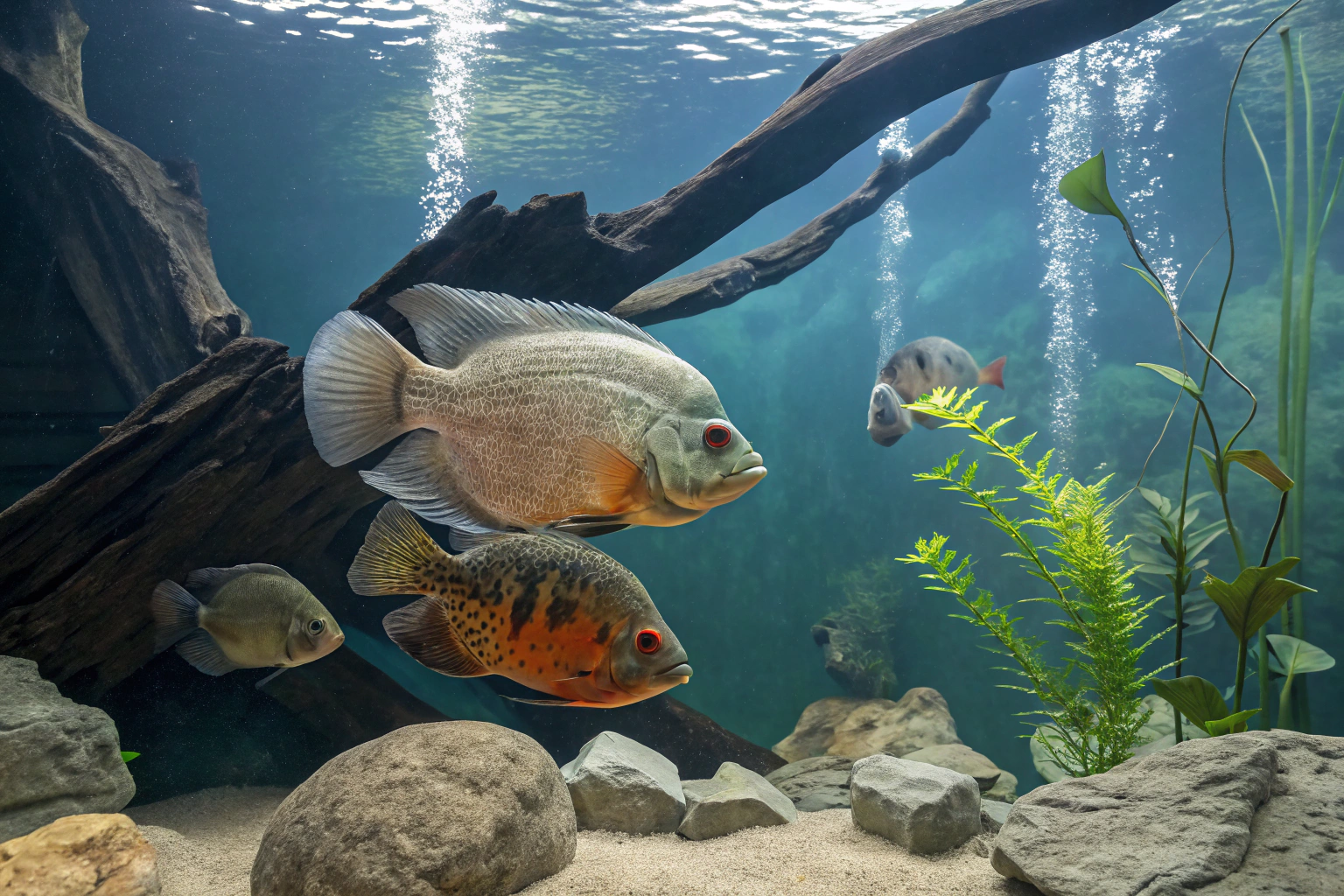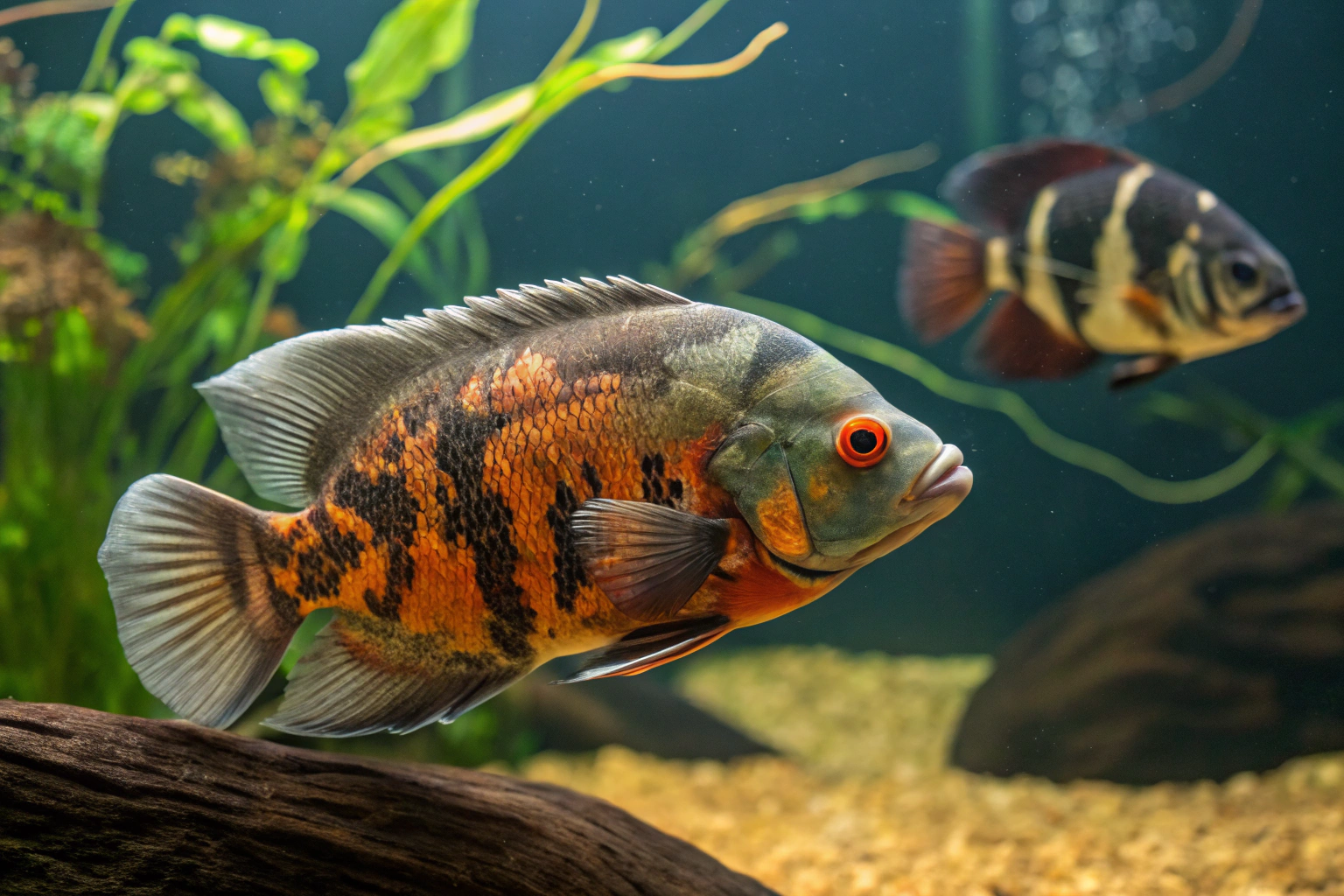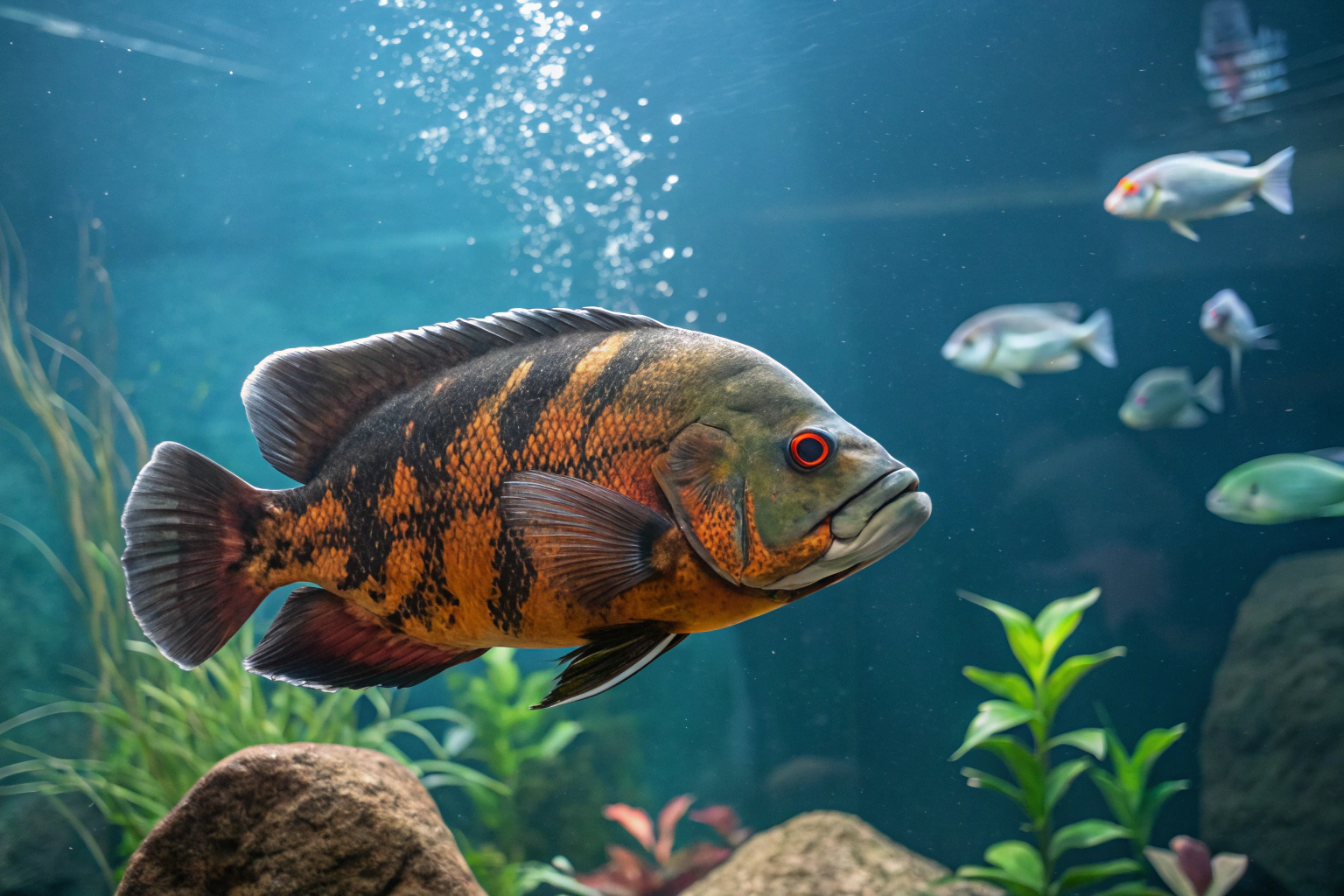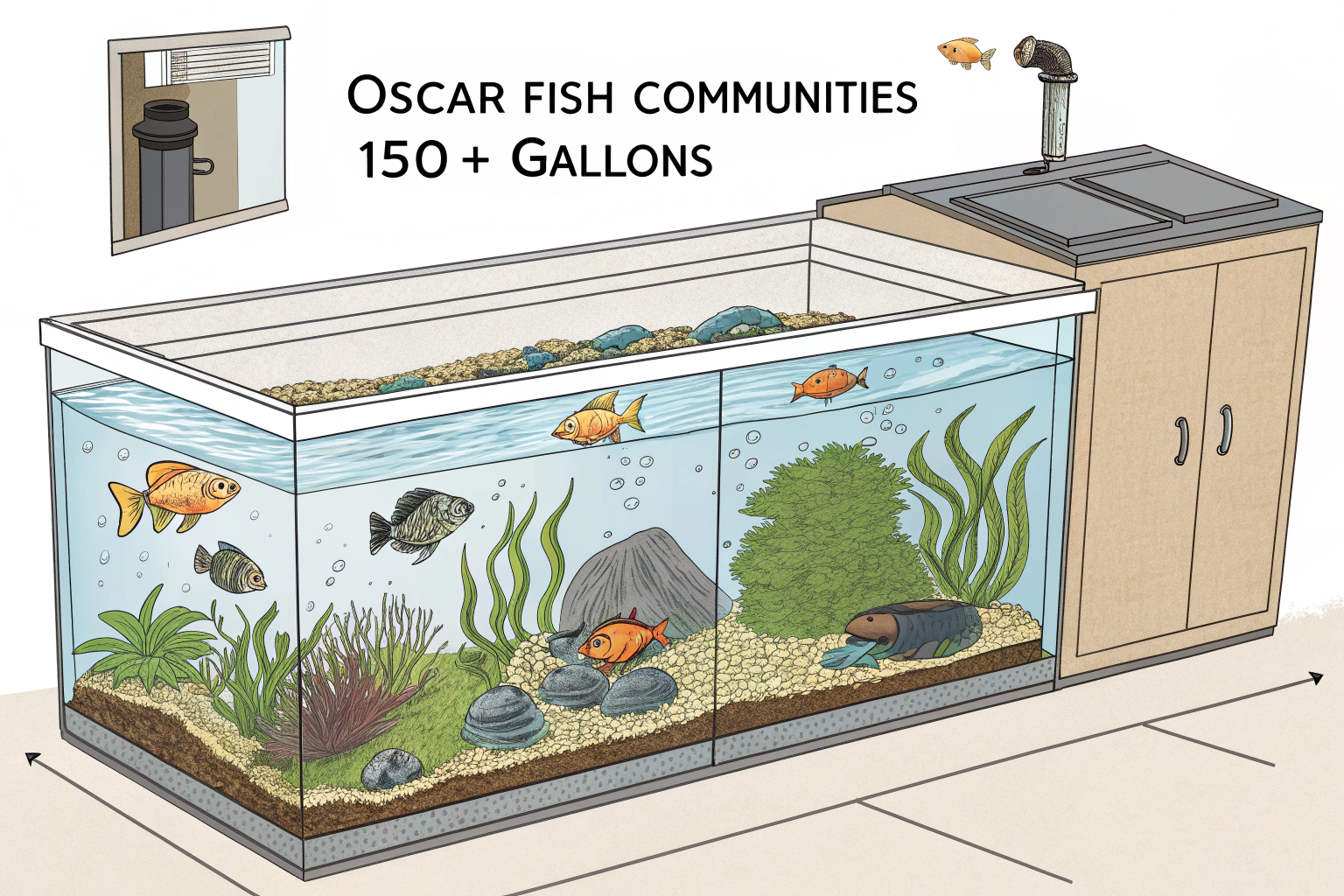What Are the Best Tank Mates for Oscar Fish: The Complete Compatibility Guide
This post may contain affiliate links.
Oscar fish are among the most popular cichlids in the aquarium hobby, known for their intelligence, personality, and striking appearance. However, finding suitable tank mates for Oscar fish can be challenging due to their size, territorial nature, and specific care requirements. This comprehensive guide will help you create a harmonious community tank while ensuring the health and happiness of your Oscar fish.

Understanding Oscar Fish Behavior and Requirements
Before selecting tank mates for Oscar fish, it’s crucial to understand their natural behavior and habitat needs. Oscar fish (Astronotus ocellatus) are large, intelligent cichlids native to South America that can grow up to 12-14 inches in captivity. They require spacious tanks (minimum 75 gallons for a single Oscar), warm water temperatures between 74-81°F, and a pH range of 6.0-8.0.
Oscar fish are semi-aggressive and can be territorial, especially during breeding. They’re also known for their messy eating habits and high bioload, which affects water quality and influences tank mate selection. Understanding these characteristics is essential for successful Oscar fish care and community tank management.
Top 10 Best Tank Mates for Oscar Fish
1. Jack Dempsey Fish
Jack Dempsey cichlids make excellent companions for Oscars due to their similar size and temperament. These robust fish can hold their own against Oscar aggression while sharing similar water parameter requirements. Adult Jack Dempseys reach 8-10 inches, making them less likely to be seen as prey.
2. Green Terror Cichlids
Green Terror cichlids are another South American species that pairs well with Oscars. Their aggressive nature and substantial size (6-8 inches) make them suitable tank mates. Both species appreciate similar water conditions and dietary requirements.
3. Firemouth Cichlids
Firemouth cichlids offer a colorful addition to Oscar tanks while maintaining compatibility. At 4-6 inches, they’re large enough to avoid predation but may require careful monitoring during Oscar breeding periods.
4. Silver Dollars
Silver Dollar fish are peaceful schooling fish that work well with Oscars when kept in groups of 5-6 individuals. Their fast swimming speed and schooling behavior help them avoid Oscar aggression, while their herbivorous diet complements the Oscar’s feeding routine.
5. Tinfoil Barbs
Tinfoil Barbs are active, fast-swimming fish that can coexist with Oscars in large tanks. Growing up to 14 inches, they’re too large to be considered prey and their peaceful nature makes them ideal community fish for large aquarium setups.
6. Pleco Catfish (Common and Sailfin)
Large Pleco species make excellent tank mates for Oscars, serving as efficient cleanup crews while being too large and armored for Oscar predation. Common Plecos and Sailfin Plecos can grow 12-18 inches and help maintain aquarium cleanliness.
7. Bichir Species
Bichirs are ancient fish species that coexist well with Oscars due to their nocturnal nature and bottom-dwelling habits. Their armor-like scales and prehistoric appearance make them fascinating additions to Oscar community tanks.
8. Large Catfish Species
Several large catfish species, including Red-tailed Catfish (for very large tanks) and smaller alternatives like Pictus Catfish groups, can work with Oscars. These bottom-dwellers occupy different tank levels and help with cleanup duties.
9. Convict Cichlids
While smaller than ideal, Convict Cichlids can work with Oscars if introduced properly and given adequate hiding spaces. Their aggressive nature helps them defend themselves, though careful monitoring is required.
10. Jewel Cichlids
Jewel Cichlids bring vibrant colors to Oscar tanks while maintaining their own territory. Their moderate aggression and medium size make them suitable companions for well-established Oscar communities.

Tank Mates to Avoid with Oscar Fish
Understanding which fish to avoid is equally important for successful aquarium management. Small fish like tetras, guppies, and other community fish will likely become expensive meals for your Oscars. Highly aggressive species like Red Devils or extremely territorial fish may cause stress and fighting.
Additionally, avoid slow-moving or long-finned fish that Oscars might nip, and be cautious with invertebrates like shrimp or snails, which Oscars consider delicacies.
Setting Up the Perfect Oscar Community Tank
Tank Size Requirements
A successful Oscar community tank requires substantial space. For one Oscar with tank mates, plan for a minimum of 125 gallons, with larger tanks (150+ gallons) being preferable. Each additional Oscar or large cichlid requires an additional 75-100 gallons.
Filtration and Water Quality
Oscar fish produce significant waste, requiring robust filtration systems. Implement a combination of mechanical, biological, and chemical filtration with turnover rates of 6-10 times the tank volume per hour. Regular water changes (25-30% weekly) are essential for maintaining optimal water quality parameters.
Tank Layout and Decorations
Create territories using rocks, driftwood, and caves to reduce aggression between tank mates. Avoid plants unless using hardy species like Java Fern, as Oscars tend to uproot vegetation. Provide open swimming areas while ensuring adequate hiding spots for all inhabitants.
Feeding Oscar Communities
Feeding multiple large fish species requires careful planning. Oscars are omnivores requiring high-protein diets, while tank mates may have different nutritional needs. Use high-quality cichlid pellets as the staple diet, supplemented with frozen foods like bloodworms, brine shrimp, and occasional live feeders.
Feed multiple times daily in smaller portions rather than one large feeding to reduce waste and aggression during feeding time. Monitor all fish to ensure everyone receives adequate nutrition without overfeeding.

Common Compatibility Challenges and Solutions
Aggression Management
Oscar aggression can be managed through proper tank setup, adequate space, and careful species selection. If aggression occurs, rearrange decorations to disrupt established territories and consider temporary separation if necessary.
Size Disparities
When housing fish of different sizes, ensure smaller tank mates are large enough to avoid predation (generally 4+ inches for adult fish). Monitor growth rates and be prepared to relocate fish that become too small.
Breeding Considerations
Oscar breeding behavior intensifies aggression toward tank mates. Provide breeding pairs with separate areas or be prepared to remove tank mates during breeding periods. Understanding Oscar fish breeding behavior helps prevent community disruption.

Maintenance Tips for Oscar Community Tanks
Regular maintenance becomes more critical with larger fish communities. Perform weekly water changes, monitor water parameters closely, and maintain efficient filtration systems. Clean substrates regularly to remove uneaten food and waste accumulation.
Test water parameters weekly, including ammonia, nitrite, nitrate, pH, and temperature. Keep maintenance logs to track patterns and identify potential issues before they become serious problems.
Conclusion: Building Your Perfect Oscar Community
Creating a successful Oscar fish community requires careful planning, adequate space, and ongoing commitment to proper care. By selecting appropriate tank mates, maintaining excellent water quality, and providing proper nutrition, you can enjoy a thriving aquarium ecosystem featuring these magnificent fish.
Remember that every Oscar has its own personality, and what works for one tank may require adjustments for another. Start slowly, monitor carefully, and be prepared to make changes as your fish grow and mature. With proper planning and care, your Oscar community tank can provide years of enjoyment and fascination.
For more detailed information about specific aspects of Oscar care, consider consulting with local aquarium specialists or exploring additional resources about advanced cichlid keeping techniques. The key to success lies in understanding your fish’s needs and maintaining consistent, high-quality care practices.
